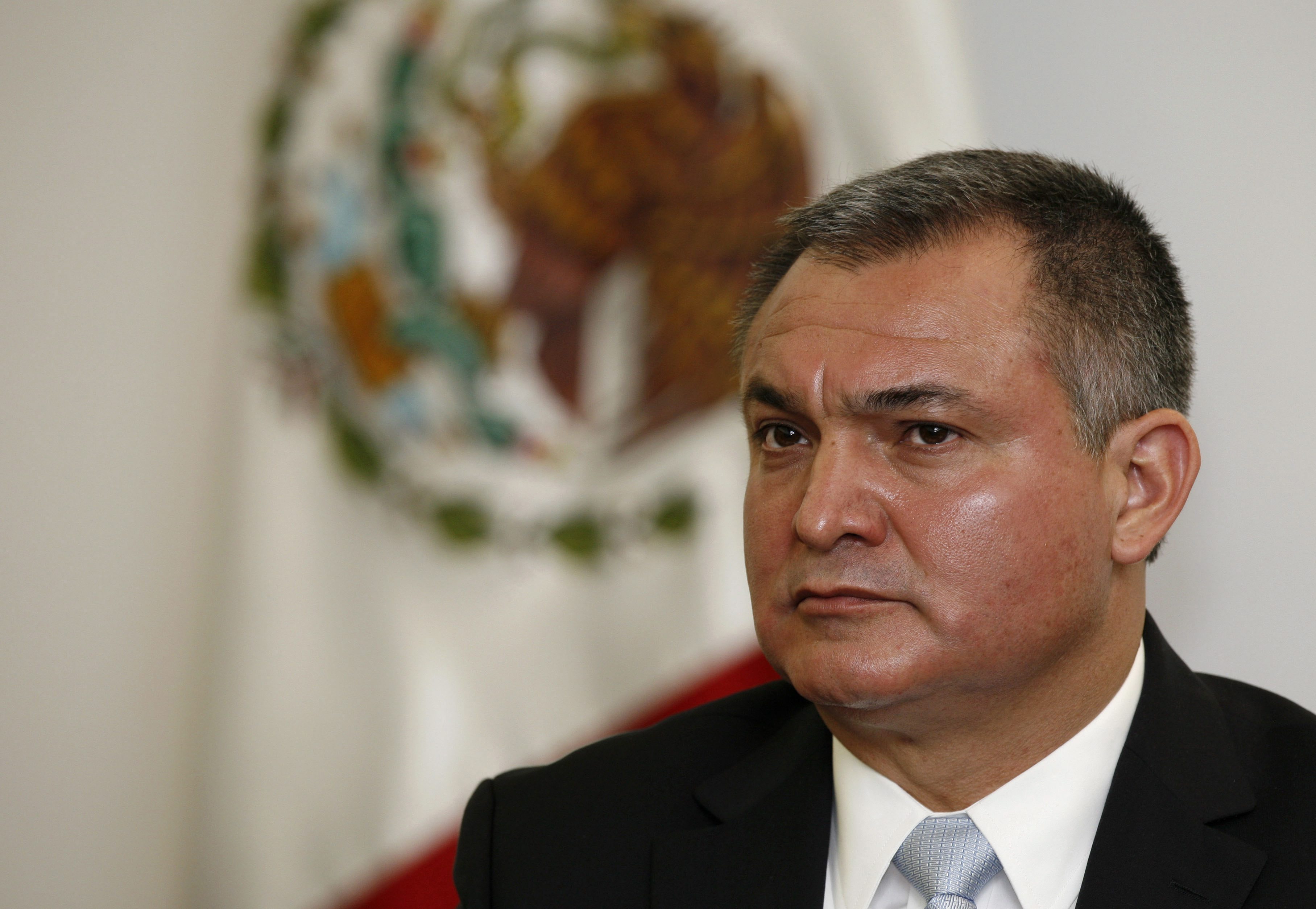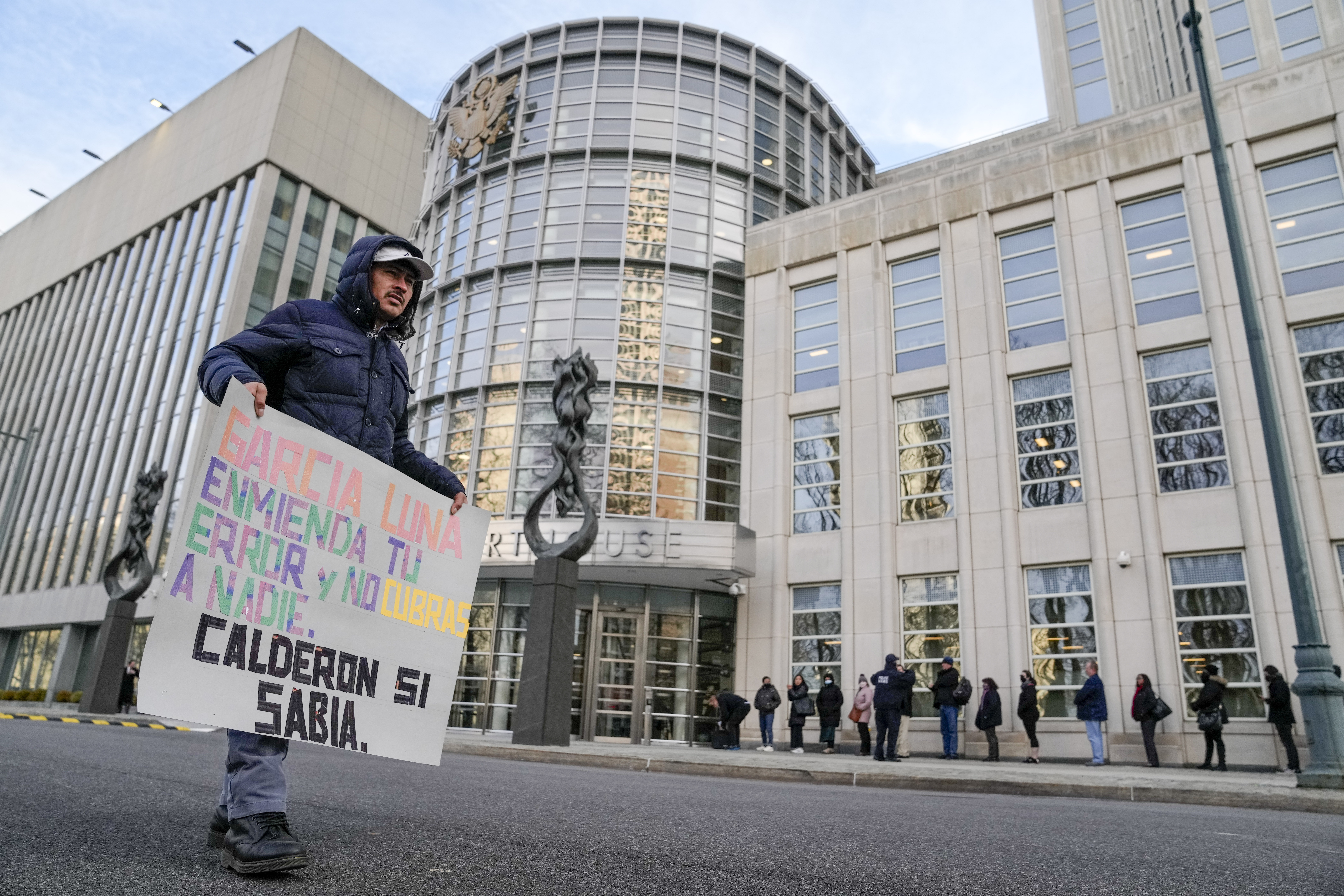Sergio Villarreal Barragán had only been working as a police officer in Mexico for a few years when he learned who really called the shots in his country. It was 1992 and he was in charge of a highway checkpoint near Ciudad Juarez, just across the border from El Paso, Texas, where he was tasked with searching vehicles for drugs, guns, and other contraband. One day, an SUV pulled up full of people wearing uniforms just like his—except these weren’t fellow cops.
The men were heavily armed. One stepped forward to identify himself as Amado Carrillo Fuentes, a feared drug cartel leader known as “The Lord of the Skies” because he owned a fleet of airplanes used for smuggling cocaine from South America.
Videos by VICE
“They pointed their guns at us and then Amado introduced himself to us and said: ‘Either you align ourselves with us or you get out of here,’” Villarreal Barragán said during testimony he delivered Monday at the federal courthouse in Brooklyn, during the trial of the highest-ranking Mexican law enforcement official to ever face prosecution in the United States.
It was an offer Villarreal Barragán could not refuse. He continued working as a police officer for several more years, but his real bosses became The Lord of the Skies and his partners in the Sinaloa Cartel, including the infamous Joaquín “El Chapo” Guzmán. Eventually, Villarreal Barragán quit the police and joined the cartel full time, serving as a top lieutenant for El Chapo’s cousin, Arturo Beltrán Leyva, who led a cartel faction called the Beltrán Leyva Organization.

Standing nearly 6’7” and nicknamed “El Grande” because of his towering stature, Villarreal Barragán was the first witness called to testify against Genaro García Luna, a former cabinet-level official under ex-president Felipe Calderón who oversaw the country’s entire federal police force and prison system. For more than a decade, until he and Calderón left office in 2012, García Luna was a trusted ally of the DEA and other U.S. law enforcement agencies. But according to El Grande, García Luna answered to the cartel just like everyone else.
Over the course of several hours on the witness stand, El Grande, who was extradited to the U.S. in 2012 and was reportedly released in 2019 after striking a plea deal, testified about rampant corruption at every level of Mexican law enforcement, from the top down. Villarreal Barragán claimed he was present on multiple occasions when García Luna took millions of dollars worth of bribes from the Sinaloa Cartel. The massive payoffs, he said, were pooled by Beltrán Leyva, El Chapo, and other cartel leaders and delivered to García Luna to ensure drugs kept flowing unchecked through Mexico. The cartel, he said, was pleased with the deal.
“It was the best investment they had of their money,” El Grande said. “We had absolutely no problems.”
Villarreal Barragán’s testimony offered a rare window into the ways the Sinaloa Cartel recruits and corrupts Mexican police officials, including those at the very top of the food chain. While publicly serving as the face of Mexico’s militarized war against the cartels under Calderón, García Luna was allegedly deep in the pocket of the Beltrán Leyva Organization.
In many ways, Villarreal Barragán and García Luna are cut from the same cloth. Apart from a substantial difference in height, the two men look like they could be brothers. Both have silver hair buzzed into flat tops, furrowed brows, and the stern demeanor of ex-cops. While García Luna trained as an engineer before joining the Mexican equivalent of the CIA, Villarreal Barragán attended two years of law school before dropping out to become a police officer.
As García Luna climbed the ranks to earn the post as his country’s top law enforcement official, Villarreal Barragán became a trusted operator for the Beltrán Leyva Organization whose job, in his own words, was to oversee “the growth and expansion of the cartel and to eliminate enemies of the cartel.”
“There are two types of corruption in government,” Villarreal Barragán explained. “One is when you pay an officer to look the other way to let something through. And the other type is when they take part in the activities of the organization.”
Garcia Luna, El Grande told the jury, was the second type.
“He was of great help,” Villarreal Barragán testified about García Luna. “He would give us information about operations against the cartel. He helped us put in and take out agents in every part of Mexico and he shared information so we could hit our rivals.”
Villarreal Barragán was eventually arrested in 2010. He previously testified in the U.S. against another former Mexican federal police officer, Iván Reyes Arzate, who was identified Monday as one of several senior officers who served under García Luna in the Mexican federal police while taking bribes from the Sinaloa Cartel. (Reyes Arzate, who had access to sensitive DEA intelligence, has twice pleaded guilty to U.S. federal indictments, and is currently serving a 10-year prison sentence.)
El Grande said that García Luna and his associates would leak useful information to the cartel, including tips about drug shipments by rival groups. On one occasion, he testified, they intercepted two tons of cocaine that belonged to the Gulf Cartel and La Familia, two enemies of the Sinaloa Cartel. The stolen load was taken to a warehouse, he said, where García Luna showed up along with two of his top deputies. The corrupt cops allegedly had a deal that entitled them to half the value of any drug shipment taken from an opposing cartel thanks to their information. In this case, he recalled, the payout to García Luna was around $14-16 million.
“It was a good amount,” El Grande said. The money was handed over in cardboard “office boxes” full of $20 bills, he recalled, and there were so many they wouldn’t fit in the SUV that the cops had driven to the warehouse, so the cartel lent them a Suburban to haul the cash away.
Villarreal Barragán offered other specific examples of bribes delivered by the Beltrán Leyva Organization to García Luna. Once, he claimed, his boss arranged to have “a special edition Harley Davidson motorcycle” purchased in Mexico City and delivered to García Luna.
Arturo Beltrán Leyva, who ran the cartel with his brothers Hector and Alfredo, would often let El Grande eavesdrop on conversations with García Luna, El Grande claimed. After the Harley was delivered, he was struck by the way the federal police official and cartel boss spoke to each other and “how familiar the tone was… as if they were friends.”
El Grande claimed he could hear García Luna talking to the Beltrán Leyva leader and “thanking him for his thoughtfulness, it was really nice.” He could tell it was García Luna, he added, because he repeatedly stumbled over his words. Behind García Luna’s back, Villarreal Barragán testified, the cartel bosses nicknamed him Tartamudo or The Stutterer.
Starting around 2001, when García Luna led the Mexican equivalent of the FBI, El Grande said the Sinaloa Cartel would deliver him monthly payments of $1-1.5 million. Villarreal Barragán said he personally observed around 20 of these payoffs, which typically occurred at a cartel safe house in the southern part of Mexico City, near a shopping mall called Perisur. The money was handed over in black duffel bags called “chorizos,” he said, which were stuffed with stacks of $100 bills packed into bundles of $10,000 each.
“Normally they’d put the bag on the table, open the zipper, show the contents, and close it again,” El Grande said, adding: “The payments increased in amount as the cartel grew because the volume of drugs and growth was greater. That meant the profits were also greater.”

Villarreal Barragán also described the lavish lifestyle that Arturo Beltrán Leyva enjoyed as a cocaine kingpin who was allowed to operate with impunity. Known as El Barbas (The Beard) or The Boss of Bosses, he owned a black panther and a white tiger as pets. His fleet of cars included a Rolls-Royce, a Ferrari, and a Lamborghini. The Beltrán Leyva leader, he said, owned “top luxury” properties and dressed “very flashy… similar to what rap artists wear,” with “flashy clothes, a lot of jewelry made by exclusive designers.”
By contrast, prosecutors seem to have little evidence that proves García Luna was living large off the millions of dollars in cartel bribes he allegedly accepted. In a pretrial ruling handed down last week, the presiding judge blocked prosecutors from presenting evidence of García Luna wealth after he left the Mexican government in 2012, saying they had failed to present any proof it was “financed with cartel money.”
In his opening statement to the jury on Monday, García Luna’s lead defense attorney, Cesar de Castro, made a point of calling out the lack of hard evidence linking his client to corruption.
“No money. No photos. No videos. No emails. No records. No documents. No credible, believable, plausible evidence Mr. García Luna helped the cartels,” de Castro said. “This case is really about the government’s lack of any objective evidence.”
What the government does have, however, is cooperating witnesses like El Grande. The judge’s ruling last week revealed the names of several other potential witnesses for the prosecution, including another top Beltrán Leyva lieutenant named Edgar Valdez Villarreal aka La Barbie for his blonde hair and handsome face. La Barbie was also one of several cartel associates name-checked by Villarreal Barragán, along with the brother of Ismael “El Mayo” Zambada, who previously testified in late 2018 during El Chapo’s trial about personally delivering a multi-million dollar bribe to García Luna.
De Castro told the jury Monday that the cooperator testimony would consist of “rumors, speculation, and the words of some of the biggest criminals in the world, many arrested and extradited by Mr. García Luna.”
De Castro showed the jury pictures of García Luna interacting with a who’s who of senior U.S. officials from the early 2000s, including former President Barack Obama and his then-Secretary of State Hillary Clinton, a previous head of the DEA, and Republican members of Congress, including Sen. Lindsey Graham.
The defense attorney suggested that the cartel members, who have cut deals with the government in exchange for reduced sentences, were out for revenge against García Luna because was the one responsible for their downfalls. The cartels “want to get the last laugh,” de Castro said, “and they want your help doing it.”
On the government side, federal prosecutor Philip Pilmar told the jury in his opening statement that García Luna was “a man who betrayed both his country and ours.”
“While entrusted to work for the Mexican people, he had another job—a dirtier job, a more lucrative job.” Pilmar said. “He took millions of dollars in cash bribes to enable the biggest drug cartel in Mexico to send tons—literal tons—of cocaine to the United States.”
García Luna faces life in prison if convicted, and Pilmar made it clear that the case will hinge on the testimony of other cooperating witnesses like El Grande.
“Witness after witness after witness will testify they and their bosses paid the defendant,” Pilmar said, describing how Mexican federal police officers were involved in unloading shipments of cocaine for the Sinaloa Cartel at Mexico City’s airport. With García Luna giving the orders, Pilmar said, “the person charged with going after the cartel was actually its most valued asset.”




